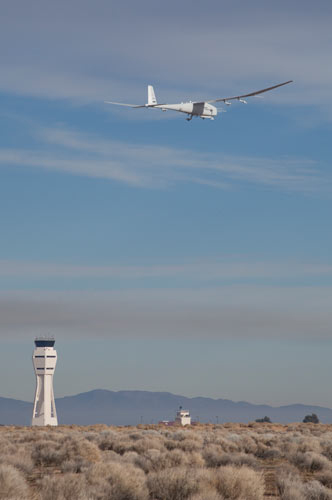AeroVironment announced that their Global Observer™ reached an altitude of 5,000 feet (mean sea level) over Edwards Air Force Base and stayed up for four hours – all on its hydrogen-powered electric motors. Having made its first flights last August and September on battery power, the Global Observer on January 11, 2011 successfully demonstrated the system that will allow it to stay airborne for up to a week at a time, staying on station at 65,000 feet.
This ability to maintain “persistent” communications and surveillance enables to the Global Observer to be flown in from areas remote from a combat theater or natural disaster location, and to uninterrupted observation of the situation. AeroVironment claims that, “Two Global Observer aircraft, each flying for up to a week at a time, will alternate coverage over any area on the earth, providing a seamless, persistent platform for high value missions such as communications relay, remote sensing, long-term surveillance and border patrol. Offering greater flexibility than a satellite and significantly longer duration than conventional manned and unmanned aircraft, Global Observer is designed to provide critical new capabilities in a reliable and more affordable manner, all while consuming no fossil fuels and emitting no carbon emissions.”
The firm claims that such capabilities will cost only 20 percent of “current solutions.”
Note that the hydrogen used in this system powers electric motors, a form of serial hybrid design, while the Boeing PhantomEye uses hydrogen stored in eight-foot diameter spheres to directly “fuel” its twin Ford engines. Both aircraft continue under test at NASA Dryden Flight Test Center at Edwards.

